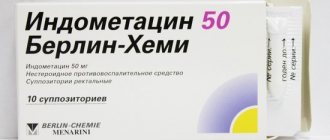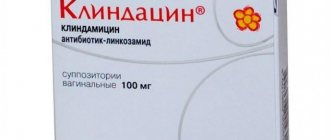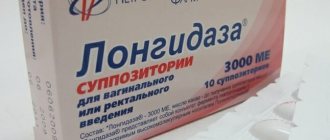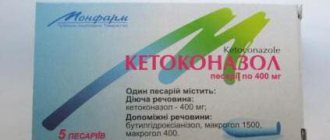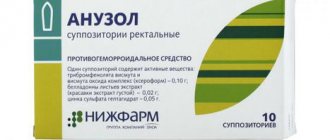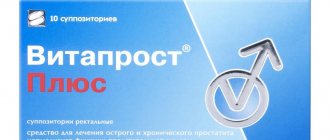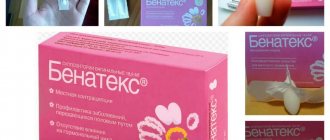- July 13, 2020
- obstetrics and gynecology
- Sofia Andreeva
For the treatment of gynecological diseases, tablets are used in rare cases, since the medicinal substance must be delivered directly to the lesion. Therefore, doctors most often prescribe special tampons, douching, lotions and suppositories. One of the popular drugs is Chlorhexidine suppositories. Instructions for use in gynecology will be discussed in detail in today's article.
Dosage form, composition
Chlorhexidine suppositories are small in size, torpedo-shaped, and white in color. The main active ingredient is chlorhexidine bigluconate, its content in 1 suppository is 8 and 16 mg. It also contains auxiliary components, which include macrogol 400 and macrogol 1500. Chlorhexidine suppositories are packaged in blister packs of 5 pieces. The cardboard pack contains 2 blister packs (10 suppositories), as well as instructions for use of the drug.
Possible contraindications
Not all patients are prescribed Chlorhexidine suppositories. According to the instructions for use in gynecology, the drug has a number of restrictions on use. For example, individual intolerance to the incoming components or a history of a tendency to allergic reactions. In addition, suppositories are not prescribed for therapeutic purposes to girls who are not sexually active.
When initial allergy symptoms appear, you must immediately stop treatment and take any antihistamine. You need to see a doctor within a few days. The specialist will select an analogue of the medication and possibly change the treatment regimen. Allergies to it are extremely rare, but the possible risk should not be forgotten.
pharmachologic effect
Chlorhexidine has a pronounced bactericidal effect. It leads to the death of gram-negative (Escherichia coli, Klebsiella, Proteus, gonococci) and gram-positive (staphylococcus, streptococcus) bacteria. It also has fairly high activity against specific pathogens of sexually transmitted infections (chlamydia, ureaplasma, trichomonas, mycoplasma), viruses (including pathogens of HIV AIDS and viral hepatitis) and fungi. After administration of the Chlorhexidine suppository, the active component is practically not absorbed into the systemic bloodstream; it remains on the mucous membrane, where it has a therapeutic effect for 4 hours.
Use of chlorhexidine
Chlorhexidine - the name of this drug is quite difficult to pronounce, but you should remember it. Why? Because it is a reliable and inexpensive antiseptic. Some doctors even claim that it should be stored in every home medicine cabinet, just in case, along with brilliant green, iodine and hydrogen peroxide. With this substance you can disinfect wounds, burns, and scratches.
Chlorhexidine has been used in medicine and in everyday life for more than sixty years. This substance was obtained in the 50s of the last century, and today the World Health Organization lists it as an essential medicine. It is used to disinfect skin, treat wounds and urinary catheters, and is also used to prevent plaque formation. Widely used in surgery for treating surgeon's hands, patients' skin and for disinfecting surgical instruments.
Chlorhexidine has a very powerful antimicrobial effect. It is effective against such dangerous bacteria as Treponema pallidum (the causative agent of syphilis), Chlamydia species (causes trachoma, pneumonia, inflammation of the urinary tract and others), ureplasma (causes inflammation of the genital organs and urinary tract), gonococcus (causative agent of gonorrhea), Gardnerella vaginalis ( causes gardenellosis). This substance can even destroy herpes viruses. (You can read about common urinary tract infections in women here).
Sometimes chlorhexidine is prescribed for thrush. (Read about the features of this disease in men here). Only a doctor can do this, since it is necessary to correctly calculate the dosage. If the amount of the drug is calculated incorrectly, it will either have no effect or burn the mucous membranes. But if an allergic reaction occurs, treatment should be stopped immediately and the doctor should be informed.
Indications
The use of Chlorhexidine suppositories is indicated for the complex treatment of various infectious pathologies of the structures of the urogenital tract of a woman:
- Bacterial vaginosis is a violation of the ratio of microorganisms on the vaginal mucosa with an increase in the number of opportunistic species.
- Colpitis (inflammation of the vagina) of various origins.
- Cervicitis is an infectious inflammation of the cervical mucosa.
The drug can also be used for the prevention of infectious diseases with predominantly sexual transmission (chlamydia, ureaplasmosis, trichomoniasis, genital herpes,). To do this, insertion of the suppository must be performed no longer than 2 hours after unprotected sex. Chlorhexidine suppositories have a good effect in preventing secondary infection, therefore they are used before gynecological operations, invasive therapeutic and diagnostic procedures (installation of an intrauterine device, diathermocoagulation, radical surgical treatment of gynecological pathology).
Hexicon lecterns
Analogues of Hexicon suppositories are produced cheaper and more expensive, the cost depends on the country of origin, the amount of active substances and units of medication in the package.
Analogues of the drug Hexicon are presented in the table
| Analogue | Price, in rubles | Manufacturer country |
| Hexicon | 240-280 | Russia |
| Chlorhexidine | 125-175 | Russia |
| Betadine | 170-870 | Hungary |
| Terzhinan | 390-570 | France |
| Polygynax | 300-600 | France |
| Depanthol | 480-520 | Russia |
| Pimafucin | 250-580 | Italy, Netherlands |
| Fluomizin | 450-550 | Switzerland |
| Neo-Penotran | 750-1050 | Türkiye |
| Elzhina | 350-500 | Russia |
| Livarol | 500-780 | Russia |
| Klion D | 300-400 | Hungary, Russia |
| Genferon | 290-700 | Russia |
| Clotrimazole | 20-200 | Russia, UK |
| McMirror | 750-1000 | Italy |
| Mentronidazole | 30-175 | Russia |
| Miramistin | 230-770 | Ukraine Russia |
| Clindacin | 400-550 | Moldova, Russia |
| Acylact | 200-280 | Russia |
| Metromicon Neo | 350-440 | Russia |
Analogs of Hexicon suppositories can contain from 1 to 4 active ingredients and fight infectious diseases of the urogenital tract. Before starting to use antimicrobial drugs, you should study the instructions for use.
Pimafucin
Manufacturer: Temmler Italy, Italy
Release form: vaginal cream and suppositories
Active ingredient: natamycin
Pimafucin contains the antifungal antibiotic natamycin. Prescribed in the form of suppositories for the treatment of: vaginitis and vulvovaginitis caused by Candida fungi.
The cream is used vaginally or topically on fungal-affected skin areas.
Fluomizin
Manufacturer: Medinova, Switzerland
Release form: vaginal tablets
Active ingredient: dequalinium chloride
Fluomizin is an imported antiseptic analogue of Hexicon. The active substance is widely effective against many infections of the reproductive system. Used for the treatment of thrush, trichomoniasis, infectious vaginosis. Used before childbirth, gynecological interventions for sanitation.
Clotrimazole
Manufacturer: GlaxoSmithKline, UK
Release form: vaginal tablets, cream
Active ingredient: clotrimazole
Synonyms: Candide, Mycotin, Kanesten
Hexicon's analogue has antifungal and antimicrobial effects. Effectively fights yeast-like fungi - thrush; trichomonas, staphylococcal and streptococcal infections.
Clotrimazole cream is an analogue of the previously produced Hexicon gel.
Tablets and cream are used vaginally.
Dosage
Chlorhexidine suppositories are intended for intravaginal use. After being released from the blister pack, they are inserted deep into the vaginal cavity in a supine position. For the treatment of infectious pathology, the dosage of the drug is 1 suppository 2 times a day, usually for 7-10 days; if necessary, the course of therapy can be extended to 20 days. To prevent infections that are predominantly sexually transmitted, use 1 suppository within 2 hours after unprotected sex.
Patient reviews
According to the majority of patients, suppositories with chlorhexidine deserve exclusively positive ratings. For a fairly low cost (a pack of eight suppositories costs only 120 rubles), they cope well with various infections. They are effective against many gram-positive and gram-negative bacteria known to modern medicine, various viruses and fungi.
Another significant advantage is the convenient form of use. The suppositories are easily inserted into the vagina, and the process itself, according to reviews, does not cause painful discomfort. The active substances of the drug act directly on the pathological focus. The safety of use makes it in demand both for the treatment and prevention of unpleasant gynecological diseases.
The visible effect is felt after the first use, as women notice. Unpleasant symptoms accompanying the disease disappear for a long time. However, their absence even for several days is not a reason to stop treatment. The standard course of therapy is about 20 days. It can be reduced only on doctor's recommendations. Changing treatment on your own is dangerous by developing complications.
Features of use
Before you start using Chlorhexidine suppositories, it is important to carefully read the instructions and pay attention to several features of the correct use of the drug:
- Toilet of the external genitalia does not affect the bactericidal activity of the drug, which is due to the fact that the suppository is inserted into the vaginal lumen.
- Chlorhexidine retains sufficient activity upon contact with organic compounds (bactericidal activity does not decrease upon contact with blood, fibrin plaque, or purulent contents).
- It is not recommended to use it together with drugs for intravaginal use that contain iodine.
- The drug is not compatible with detergents containing an anionic group (sodium lauryl sulfate, saponins, sodium carboxymethylcellulose) if administered intravaginally.
- The drug does not directly affect the functional state of the structures of the nervous system, the speed of psychomotor reactions and the ability to concentrate.
In the pharmacy chain, Chlorhexidine suppositories are available with a doctor's prescription. It is recommended to consult with a medical specialist before using them.
Popular analogues
The drug described in the article has a number of restrictions on its use, and in some cases it can provoke the development of an allergic reaction. In these situations, the doctor should prescribe its analogue. Modern pharmaceutical companies offer a wide range of similar medications used in gynecology. In most cases, Chlorhexidine suppositories can be replaced with one of the following drugs:
- "Citeal".
- "Hexicon".
- "Depantol".
- "Betadine."
- "Polygynax Virgo".
- "Levometrin."
Some drugs also have chlorhexidine as an active substance. In others, it is replaced by metronidazole or neomycin - components with similar therapeutic effects.
Analogs can be produced both in the form of suppositories and in the form of solutions for douching or intravaginal tablets. Depending on the course of the disease and associated health problems, the specialist will prescribe the appropriate form of medication.
special instructions
In some cases, the use of candles should be abandoned.
Prescription for children
Suppositories are not prescribed to girls and women under 18 years of age.
Suppositories are not prescribed to girls and women under 18 years of age.
Use during pregnancy and lactation
During pregnancy, the drug is used only for the sanitation of the genital tract before childbirth. Candles should not be used when the water begins to break. During breastfeeding, suppositories are used with caution.
For skin damage
The liquid form of Chlorhexidine should be used for minor wounds and burns on the body as an antimicrobial and antiseptic.
As an antiseptic for shallow skin wounds and burns:
- a solution of Chlorhexidine (no more than 1%) undiluted must be neutralized or treated the surface of the damage. You don’t have to use gauze, but apply the drug to the wound surface directly from the bottle;
- The same should be done for shallow burns, as first aid. It is necessary to pour liquid Chlorhexidine 1% onto the damaged burn area of the body. In this case, the drug will perform several functions - the role of an antiseptic, a cooler of the burn surface and at the same time wash the area of skin affected by the burn.
As a medicine for shallow cuts or scratches of the skin and simple burns:
- to the site of damage - whether it is a wound or a burn, you should apply a piece of cotton cloth soaked in medicine and tie it to the damaged area;
- dressing should be done in the morning and at night;
- Chlorhexidine can be combined in combination therapy;
- The course of treatment is determined by the surgeon or until the symptoms of the disease disappear.
Liquid Chlorhexidine should be used to disinfect the skin in various situations:
- For antiseptic treatment of the upper extremities, the surgeon should wipe his hands with the medicine before the operation. The processing time lasts about 3 minutes. Then you need to rinse your hands with clean running water and dry them with a device using clean air;
- before examining the genitourinary canal in women and men, it is necessary to rinse the urethral area with a liquid solution of Chlorgeskidine;
- use of a drug solution as an antiseptic before surgery. In this case, you need to wipe the area of the intended section with liquid Chlorhexidine (1%) - rinse with water. Afterwards, repeat the procedure and do not use water.

